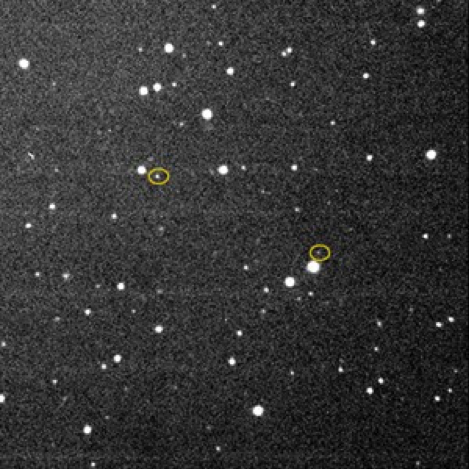The Oakley Observatory is primarily a teaching observatory, but we are capable of carrying out small telescope research. Small telescope research is important because the universe is a big place. Professional astronomers with large telescopes simply cannot keep track of everything that is going on.
Rose-Hulman students are currently active in research in the field of asteroid astrometry and asteroid photometry. Asteroids are identified by their motion relative to background stars. The Oakley Observatory is also equipped for conducting research in variable star photometry, searching for supernovae or searching for comets.

First asteroid discovered by a Rose-Hulman student.
Asteroid astrometry is the precise measurement of the location of an asteroid at a precise moment in time. Position measurements are made to a fraction of an arcsecond (an arcsecond is 1/3600 of a degree) and the time is measured to the nearest second. The results of our observations are reported to the Minor Planet Center at the Harvard-Smithsonian Center for Astrophysics. Our observations are combined with those from observatories all over the world in order to precisely determine the orbit of the asteroids. Once the orbits are accurately known, then the location of the asteroid may be determined many years into the future.
In the process of measuring asteroid positions, Rose-Hulman students have discovered more than 30 asteroids. Asteroid discoverers are permitted to name their discoveries. We have named several asteroids after major supporters of the observatory as a way to thank them and honor them for their generosity. Check out the full list of our asteroid discoveries.
Asteroid photometry is the precise measurement of the brightness of asteroids. Asteroids, also known as minor planets, shine by reflected sunlight just like the moon and planets. But unlike planets or the moon, minor planets are generally not spherical in shape. A basketball would be a good model for a planet and a good model for a minor planet would be a potato. As the potato (minor planet) rotates, you would see a large surface area at one time, but later you would see a small surface area. As time goes on, you would see a large surface again as the backside of the potato becomes visible again, and the cycle repeats. The large areas reflect more sunlight and appear brighter while the small ends appear dimmer. We measure these brightness changes and plot the results to determine the rotational period of the asteroid.
Typically, we observe five to eight asteroids each night for several nights. When we have enough data to determine the rotational period we publish our results in the Minor Planet Bulletin.
Other scientists use these data for dynamical studies of individual minor planets, families of minor planets and the origin and evolution of the solar system. We have been contacted by scientists worldwide with requests for copies of our data.
As of June 30, 2014, we have published 378 minor planet light curves in 37 different journal articles. This work has involved 76 Rose-Hulman students, three Rose-Hulman faculty and six high school students.

